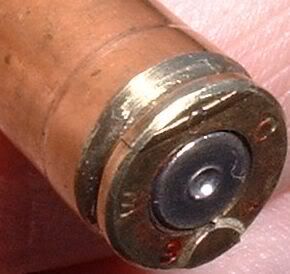Re: Load Development: Where and How to Start?
<div class="ubbcode-block"><div class="ubbcode-header">Originally Posted By: Clark</div><div class="ubbcode-body">
Pressure signs in this case I fired in an AR15:
1) Case stretch in front of the web
2) Cratered primer
3) Imprint of extractor hole in breech face
4) Imprint of ejector hole in breech face
5) [Not visible] loose primer pocket makes next primer insertion too easy
6) [not visible] extractor groove has grown and the change can be measured with dial calipers
This brass I fired in a Ruger #1 223 that does not make extractor or ejector marks on case head.
The published load:
Hodgdon website: 223 Rem, H335, 25.3 GR. 55 GR. SPR SP, 2.200", 24" barrel, 3203 fps, 49,300 CUP
Loads in picture: CCI 400 small rifle primers, LC brass once fired processed from Scharch and prepped by me, 55 gr Vmax moly, H335
pic left to right: unfired, 28, 29, 30, and 31 gr.
unfired, extractor groove .329"
28 gr, extractor groove .329", 11% overload
29 gr, extractor groove .329", 15% overload
30 gr, extractor groove .3295", 19% overload
31 gr, extractor groove .3320", 23% overload
Notice how between 15% extra powder and 19% extra powder, that the extractor groove changed .0005".
This does not mean that the primer pocket got loose in one firing, but it does mean that the primer pocket will get loose in several firings.
I have found that measuring the extractor groove before and after firing is a much better indicator than how hard it is to insert the next primer.
And noticing a reduced effort inserting the next primer is a much better indicator than noticing if the last or next primer falls out. Primers falling out is something we are trying to avoid, but hopefully not the indicator we use to avoid it.
The 1950 .223 Remington case head is based on the 1950 design .222 Remington case head. When built with small Boxer primer pockets is good for 75,000 psi handloads for an individual rifle with long brass life [primer pockets do not get loose quickly].
The SAAMI registered pressure for the 223 is 55,000 psi. = 36% safety margin
the 6mmRem and 270Win are patterned after the 1889 7.65x53mm cartridge. When built with large Boxer primer pockets is good for 67,000 psi handloads for an individual rifle with long brass life [primer pockets do not get loose quickly].
The SAAMI registered pressure for the 6mmRem and 270Win are 65,000 psi. = 3% safety margin
Notice that the 223 case head has 36% extra safety margin in case head strength relative to SAAMI pressure registration, while the Mauser case head has 3%.
The difference can be exploited by expert handloaders [who know which rifles are much stronger than the brass], but novices should use published data.
I have drilled gas holes, built regulators, and changed recoil springs to tune the rifle to the load.
You, instead, probably want to tune the load to the rifle.
Some fast powders and light bullet combinations will not cycle an AR15, with any amount of powder.
Some slower powders and heavier bullets combinations with high powder charges can slam the bolt carrier into the receiver.
Many AR15s have NATO chambers. The longest cartridge over all length that will fit in an AR15 magazine will not reach the lands. The longest bullet barely seated in the case mouth may not reach the lands if fed single shot. This long jump to the lands can double groups size. Do the best you can with what you have got.
Feeding from an AR15 magazine into an AR15 chamber can bend and beat up a cartridge. This can affect group size. Do the best you can with what you have got.
So, what are you looking for in a load?
1) Long brass life [take dial calipers to the range to measure extractor groove growth]
2) Cycles the action [ejects case and feeds a new cartridge into chamber without jamming]
3) Does not slam the bolt carrier into the receiver [ejected brass should land nearby]
4) Precision [small groups] </div></div>
This is quite helpful. I liked all the info in text and photos on what over-pressure may look like. Never heard of measuring extractor groove growth, but will definitely check that. Yes, I want to tune the loads to this rifle.
The rifle is an AR15, using a Krieger barrel that has been chambered to 223 Remington, not NATO specs. I am loading via the mag (no single shot). My answer to what I am looking for in a load is #4, small groups. I would like #1 (long brass life), but know semi-autos can beat up brass. Reliable feeding is important. I have a net to catch brass.
My barrel is a 1:9 twist and am shooting at 100 yards. I have 52, 53, 55, 60, 68, and 69 grain bullets from Berger, Sierra, and Hornandy. I also have Vhitavouri N133, Hodgdon H322 and Varget, and Reloader 15 powders. I thought I would start off with a Sierra "accuracy load" for an AR15. That is a Sierra 53 grain HPFB bullet loaded to 2.250" OAL with 23.5 grains of Vhitavouri N133 powder. I would start out with their stated minimum load of 22.3 grains, working up. I am using Winchester unfired brass and Remington 7-1/2 primers.
Phil



